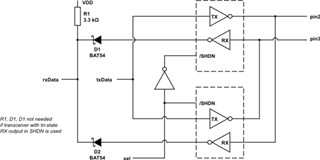Other Parts Discussed in Thread: TMUX7234
Tool/software:
Hello,
I had asked a question previously about using the TMUX7234 to switch RS232 signal lines. After doing more research I was able to come up with a design and would like some feedback if at all possible.
Referencing the image below and an explanation where someone stated that since the outputs are tri-stated they can be connected together without harming one another. I have created the schematic layout, which is attached. Am I missing anything? Does this design look like it will work?



